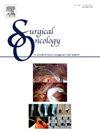High comorbidity and tumor proliferation predict survival of localized breast cancer patients after curative surgery: A retrospective analysis of real-world data in Finland
IF 2.4
4区 医学
Q3 ONCOLOGY
引用次数: 0
Abstract
Background
The aim of this study was to analyze the characteristics of breast cancer patients and their impact on real-world treatment and survival outcomes.
Patients and methods
We conducted a retrospective study including all patients newly diagnosed with breast cancer during 2019 in the Southwest Finland. We identified 458 patients diagnosed with either localized (n = 435, 95 %) or metastatic (n = 23, 5 %) breast cancer.
Results
In localized breast cancer, the five-year overall survival (OS) was 90.9 %, while the five-year disease-free survival (DFS) was 93.5 %. In metastatic breast cancer, the five-year progression-free survival (PFS) was 13.0 % and five-year OS 34.2 %. The median PFS was 10.9 months (95 % CI 2.5–19.4 months) and median OS was 30.6 months (lower 95 % CI 6.9 months – not reached).
In the univariate analyses, the most important tumor-specific parameters predicting decreased DFS were tumor proliferation index >20 %, low estrogen receptor expression status and tumor size >2 cm. Univariate predictors for decreased OS included Eastern Cooperative Oncology Group (ECOG) performance status ≥2 and Charlson Comorbidity Index (CCI) score ≥3. In the multivariable analyses, CCI score ≥3 and high proliferation index (21–100 % vs. 0–20 %) predicted poorer DFS, while CCI score ≥3 and increased stage (stage 2 vs. 1) predicted poorer OS. The administration of post-operative radiotherapy was significant in the multivariable analyses of both DFS (HR 4.23, 95 % CI 1.85–9.67, p = 0.0006) and OS (HR 6.84, 95 % CI 3.33–14.02, p < 0.0001).
Conclusion
Our results demonstrate that careful clinical evaluation of ECOG and comorbidities, alongside well-established tumor characteristics predict patient survival in a population where overall five-year survival in breast cancer is over 90 %.
高合并症和肿瘤增殖预测根治性手术后局限性乳腺癌患者的生存:芬兰真实世界数据的回顾性分析
本研究的目的是分析乳腺癌患者的特征及其对现实世界治疗和生存结果的影响。患者和方法我们在芬兰西南部进行了一项回顾性研究,包括2019年新诊断为乳腺癌的所有患者。我们确定了458例被诊断为局限性(n = 435, 95%)或转移性(n = 23, 5%)乳腺癌的患者。结果局限性乳腺癌患者5年总生存率(OS)为90.9%,5年无病生存率(DFS)为93.5%。在转移性乳腺癌中,5年无进展生存率(PFS)为13.0%,5年OS为34.2%。中位PFS为10.9个月(95% CI 2.5-19.4个月),中位OS为30.6个月(低95% CI 6.9个月-未达到)。在单变量分析中,预测DFS降低的最重要的肿瘤特异性参数是肿瘤增殖指数>; 20%,雌激素受体低表达状态和肿瘤大小>; 2cm。降低OS的单因素预测因子包括:东部肿瘤合作组(ECOG)表现状态≥2,Charlson合并症指数(CCI)评分≥3。在多变量分析中,CCI评分≥3和高增殖指数(21 - 100% vs 0 - 20%)预测较差的DFS,而CCI评分≥3和分期增加(2期vs 1期)预测较差的OS。在多变量分析中,DFS (HR 4.23, 95% CI 1.85-9.67, p = 0.0006)和OS (HR 6.84, 95% CI 3.33-14.02, p <;0.0001)。结论:我们的研究结果表明,对ECOG和合并症进行仔细的临床评估,以及确定的肿瘤特征,可以预测乳腺癌患者5年总生存率超过90%的患者的生存。
本文章由计算机程序翻译,如有差异,请以英文原文为准。
求助全文
约1分钟内获得全文
求助全文
来源期刊

Surgical Oncology-Oxford
医学-外科
CiteScore
4.50
自引率
0.00%
发文量
169
审稿时长
38 days
期刊介绍:
Surgical Oncology is a peer reviewed journal publishing review articles that contribute to the advancement of knowledge in surgical oncology and related fields of interest. Articles represent a spectrum of current technology in oncology research as well as those concerning clinical trials, surgical technique, methods of investigation and patient evaluation. Surgical Oncology publishes comprehensive Reviews that examine individual topics in considerable detail, in addition to editorials and commentaries which focus on selected papers. The journal also publishes special issues which explore topics of interest to surgical oncologists in great detail - outlining recent advancements and providing readers with the most up to date information.
 求助内容:
求助内容: 应助结果提醒方式:
应助结果提醒方式:


